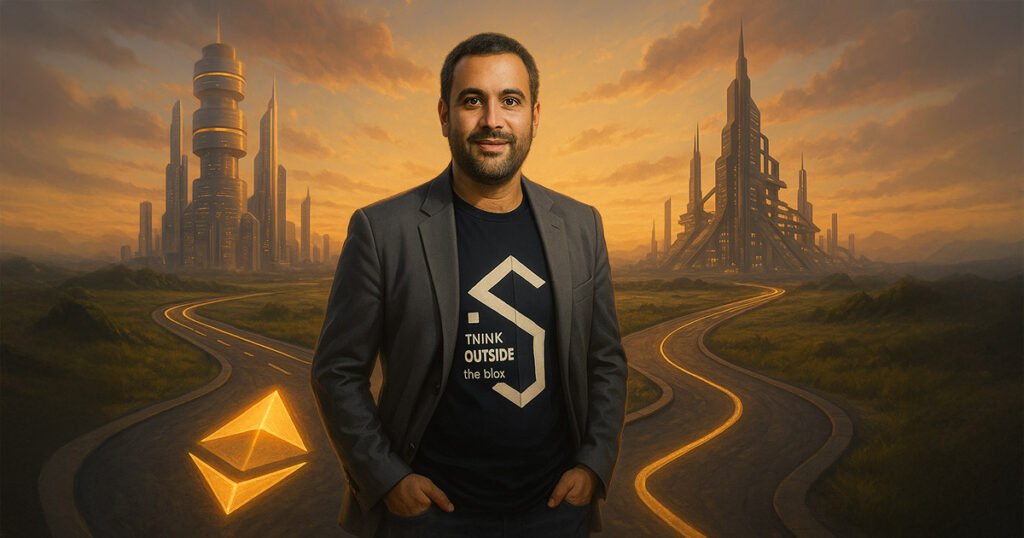Welcome to Slate Sundays, we present new weekly features from Cryptoslate, with in-depth interviews, expert analysis, and thought-provoking enlightenment beyond headlines to explore the ideas and voices that will shape the future of code.
Aron Mrock is a man of mission. As the founder of SSV Labs, a contributor to SSV Network, the second largest Ethereum Staking Infra provider, Alon has been passionately defending the virtues of the industry’s two coins since its early days. Long before Ethereum switched to stock proof, Aron contributed to his first Ethereum client. And ETH’s inactive performance and knockdown prices are bothering him. a lot.
In fact, beyond talking at the staking summit, it is one of the troops that today bring Aron to Dubai, raising awareness about the elephants in the room. He explains:
“I think most of the negative feedback that Ethereum is getting right now is due to tokens, not technology, and Ethereum needs to be aware of that. The Ethereum community needs to be aware of that and prioritized it.
With 100,000 Ethereum Validators, SSV Network ensures about 10% of all pile ETH, so Alon is investing heavily in seeing the price of tokens rise. And his sense of urgency is clear.
“We don’t focus enough on the story and the reasons to hold ETH, which is why ETH is something like this,” he laments.
Deep in the weeds of Ethereum, deep in the souk
This is the first time I’ve met Aaron and although I’m not familiar with his temperament, I can say there are plenty in his mind. ETH is priced at just one, which plagues under $1,800. After at least 20 minutes of scheduled meeting time, he had already ordered coffee when I arrived at the busy patio.
After crossing the outdoor area between the conference hall and the Madinat Souk in the punishing afternoon heat, my trend is heading for a nice cold beer than a steamy hot cappuccino. I walk in circles, deep in the depths of sark mouse perfume, textiles, stuffed animals, dates and multiple other nicknacks, then sway and red face. That Starbucks were harder to find than a shady patch in the Sahara.
Aaron must have had no problem. After navigating many twists, turns and story changes for Ethereum for a decade, Google Maps was probably walking around the park. He apologises for his poor map reading skills and asks what attracted him to Ethereum in the first place.
“Ethereum is at the forefront of decentralization…” he replies. “I was at Ethereum from the beginning.”
The divided community where ETH prices step in and swing around in that direction, as well as the scores of better, faster, cheaper alternative smart contract platforms, ask Aron if Ethereum still holds its central role today. He pauses:
“Yes, and no. Ethereum, blockchain, I think so. The roll-up-centered roadmap has proven itself and continues to prove itself. From the perspective of Ethereum on scale, the technology is very innovative. Good.”
“Dangerous Emissions” Between ETH, Tokens and ETH, Blockchain
He has mentioned several times the worsening disparity between the Ethereum blockchain and its native tokens. I ask him to expand.
“When it comes to tokens, it’s very far behind, and what’s happening there is very dangerous for Ethereum. We can discuss the differences between Solana, Cosmos, Polkadot and Ethereum until tomorrow. Bitcoin is behind as a technology, but the actual adoptions aren’t translated very well.
surely. But if the problem with Ethereum is merely creating a better story, why would the project move to other ecosystems in search of a more favorable economic model, such as UNISWAP and DYDX? He is not step-by-step:
“There are always other projects that prefer blockchains. I think that’s a much more marketing opportunity than anything. You can find very cheap transactions at Ethereum.”
He drinks coffee before doubled:
“The challenges Ethereum currently has are not technical. It’s mainly a story, a simple question. It’s a very big question.”
He explains that while Ethereum traditionally paid less attention to narrative, marketing and PR, times have changed and it has become impossible to ignore.
“Previously, institutions came to cryptography to learn and then went straight to Ethereum because that was the only game in town. Now, if you’re watching Wall Street today, they might not care about it, but it might not care about it. Use them, and it’s coming up with a compelling story.”
Finding a new reason for being for Ethereum in the mind and mind of token holders is by no means a feat, especially in an industry where not everyone is “for technology.” When NGU stopped delivering and prices steadily fell, Aron cut out his work.
“When you buy bitcoin, you hold one of the 21 million people. That’s fine. It’s a good story, and Wall Street and Traffy and everyone else really lead to it. The story of Solana is “You can beat Ethereum.” So the reason for holding a Sol is that if there is a price difference between the token and the Sol win, it is better to hold a Sol over anything else. ”
First as a bitcoiner, I confess that I’ve been asking the same questions for several years, but I don’t tell Aron that’s the case. Instead, I’m waiting for his answer:
“No one in ETH will win and compete. They are already the biggest smart contract platform, so they need another expansion. Historically, there was a very good reason to keep ETH. To use ICOs, we had to keep ETH to get into ICOs.
What is the reason for now? On my part, it’s about making Ethereum the overall Internet of value trust and security layer. If you can bring value back to the token, ETK, there’s a really good reason to keep it. ”
Why is Ethereum a good payments tier compared to other blockchains? Bitcoin security is widely known, I point out. Aron Skov:
“Bitcoin has zero smart contract capabilities, so developers basically hacked how to secure things with Bitcoin. Ethereum has smart contracts, so many of these types of use cases have become Ethereum contracts.
These validators know how to run high-performance software for a very long time. There are chain entities with performance and more, and there are more off-chain components that are responsible for extremely important application services and more. If you can run all of these services on Ethereum using Validators to pay your compensation, this revenue and compensation flow can be returned to the ETH owner. ”
Bitcoin, Ethereum, Solana, ah!
Aron doesn’t miss the opportunity to share his opinion as a legacy tech about Bitcoin, but what are his thoughts on Solana? This seems to be an institutional investor’s favorite toy. He responds that Ethereum’s “last good competitor” is EOS, but failed because “their founders did something else.” He says Solana is “basically what EOS should be like if there were serious founders,” but:
“In terms of technical capabilities, Solana is taking way more trade-offs than Ethereum. It’s not technically as sound as Ethereum, especially from the decentralization, censorship-resistant, and stability point of view. Nonetheless, they’re doing a lot of other really good work, interacting with developers, promoting themselves, communicating why Solana, et cetera, et cetera, et cetera. Ethereum needs to take some of that into what they do.”
I mentioned a POV that I heard Ethereum should not switch to stake proof. Given the nature of Aron’s business, I’m not surprised when he closes it immediately. He interferes:
“It was one of the best decisions. The amount of resources needed to maintain Bitcoin today is crazy. It’s crazy. It’s crazy. Keep having the plants and cars that powered coal and don’t switch to gasoline or electricity. Why coal is so robust. We’ve been stuck in the past in terms of technological advancements. Of course, we had no doubt about it.”
I’ll keep it
In addition to warning everyone about the problems facing Ethereum, what else is Aron doing to turn the Ethereum ship? He fixes me:
“There’s a challenge here. That’s not a problem. It’s not systematic. Times change and there’s competition, so it’s a challenge that needs to be tackled.”
What are the base applications pioneered by SSV?
“Based applications are the names of the services, protocols, and types of applications that run on Ethereum Validators. Basically, it’s SSV 2.0. I’ve created a termbase app. These are applications that are based on security on Ethereum Vidalators. That’s why they’re called bases.
This is a type of distributed application that runs on Ethereum Balidators and gets functionality and security from them. It can be Oracle or Bridge, Data Availability, ZK Proof, AI Agent, or any type of application running in a distributed manner. Instead of reinventing the wheels and building your own set of validators, you can use Ethereum to connect to Ethereum in a much better way, simply by providing much better security. ”
Where do base applications fit into a broader security environment? Also, how do you stack Eigenlayers, etc.? He explains:
“The lamina is similar in that it provides security. The main difference is that the lamina uses capital. It uses Ethereum validators. Therefore, Eigenlayer takes a large amount of capital and locks it into smart contracts.
What we decided to do is to use Validators itself. This is 95% cheaper and directly represents a part of the value of Ethereum, thus providing properties where capital is not. ”
Suddenly, it all makes sense. The base application benefits from the superior level of security offered by the base layer, and Ethereum receives compensation rather than the value extracted. Plus, Aron says, “about 95% cheaper.”
“Security is the most expensive component of a distributed service, and its base applications are very consistent with Ethereum, so that’s very important because, as I said before, it comes from the point of creating more value for its holders.
I wish him good luck and we conclude the interview. Despite Aron Badmouth dunking Ethereum as often as Bitcoin, I can’t imagine crypto space without it. bright side? When the all-time high gets 60% off, the only way you can go is up.
It is mentioned in this article

